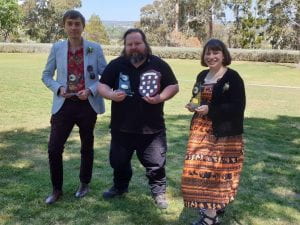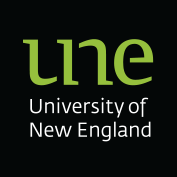Image: Archaeologists, Daniel J. Leahy and Dr. Silvano Jung, at the wreck of North American B-25 Mitchell bomber N5-156 in the Northern Territory, May 2021. (Photo by Nicole Smith).
You know you are doing what you love when you describe your studies as being exactly what you have ‘always wanted to do’. These are the words of PhD student Daniel Leahy who has been studying with UNE for over six years, but his passion for the field of Second World War aviation goes all the way back to his childhood.
“I grew up in Albury in southern New South Wales and, as far as I remember, as a kid I always wanted to become a palaeontologist – so much so that I knew how to spell the word before my kindergarten teacher did. As I continued through primary school I grew interested in the history of Second World War aviation after being given some old plastic model kits, seeing the movie Memphis Belle on television, and having discussions with a family member who served as a pilot with the RAAF during the conflict. I remember watching an obscure British documentary, Some of Our Airmen Are No Longer Missing, which dealt with the recovery of human remains from Second World War aircraft wrecks in Europe and thinking, ‘I want to do that!’”
“Unfortunately, members of my family and their friends were either of the opinion that ‘there’s no future in history’ or that gaining employment in the field would be so tough that it wasn’t worth even aiming for. As a child, I had no reason to dispute these claims. I ultimately followed my uncle into the information technology field yet continued studying the history of Second World War air power essentially as a hobby. I visited numerous historic sites in Australia, Papua New Guinea, and Canada before being asked to join an American non-profit organisation, Pacific Wrecks, which had gained a contract with the American military’s Joint POW/MIA Accounting Command (JPAC) searching for missing aircraft in PNG.”
“Once the JPAC contract ended, I had to make a choice – return to work in the IT industry, or bite the bullet (so to speak) and formally study archaeology. Fortunately, I chose the latter. While approaching my studies from this almost reversed angle has, at times, been problematic, I argue that it has provided me with a great amount of information for potential future projects and a unique perspective on such activities. And while archaeologists don’t dig dinosaurs, I do still think that they are cool.”
Daniel’s journey with UNE began with a Bachelor of Arts majoring in Archaeology and History in 2015, and once he graduated Daniel studied his Honours in 2018 ‘looking at the archaeology of airfields used by the Empire Air Training Scheme during the Second World War’. Both of these were studied as an external student so it wasn’t until part way into his PhD project that he moved to Armidale.

Dr. James Roberts, Daniel J. Leahy, and Meaghan ‘May’ Zarb with the three ‘Clubbie’ trophies awarded to the UNE Archaeology Society in October 2020. (Photo by the UNE Photography Society).
Now in his the third year of his PhD, Daniel told us about his PhD project which looks at the archaeology of Second World War air power in Australia. “The project investigates how the design and location of air power facilities – such as airfields, radar sites, anti-aircraft artillery positions, etc – changed as Australia’s strategic position changed during the Second World War. Being in my third year, my main task is to now write up the results of my research and complete my thesis.”
“For example, at the outbreak of war in September 1939, the conflict itself seemed distant, and Australian air power assets were primarily used to train Australian service personnel under the Empire Air Training Scheme, who would then take the war to what were essentially Britain’s enemies in the skies above Europe and later North Africa. With Japan’s entry into the war in December 1941, this changed dramatically. Not only was Australian air power now being used to defend Australia itself, but American and Dutch air power assets were also utilising the nation as a launching point to attack Japanese military assets in the islands to the north. While these facts are known from the history books, one of my tasks is to look at the material remains to see if they can add further information to what is already known.”
Despite early nay-sayers, Daniel hopes to turn his well-earned study achievements into a career working at an institution such as the Australian War Memorial. “I volunteered there in person while I was living in Canberra. Since leaving Canberra, I have also assisted with their transcription projects, provided expert advice on the identification of aircraft parts identified in some wartime photos, and donated a seat from a Second World War era flying boat to their collection.”
While his study journey isn’t complete just yet, Daniel took some time to reflect back on some of the highlights of his study. While Daniel is incredibly passionate about his study there have been some specific opportunities that stand out.
“While taking part in this journey with UNE, I’ve been involved in a survey of a Second World War Brewster Buffalo aircraft wreck in Victoria which has seen that site registered on the Victorian Heritage Inventory and recognised as a protected heritage site. I’ve also nominated the wreck of B-25 Mitchell N5-156 in the Northern Territory for protection – something which the Heritage Council of the Northern Territory is currently working on. Knowing that such sites are now – or will soon be – legally protected from salvage by collectors or those intending to make money from the sale of such historic artefacts, is something I have been a proponent of for a number of years, and being able to now make that difference means a lot.”
“I have also been heavily involved with the UNE Archaeology Society and served as the Society’s President from 2019-20. I take pleasure in the fact that I’m able to, in some small way, share my knowledge and experience with new students through this close-knit group. Knowing that the Society received three UNE Life ‘Clubbie’ awards while I was President has been a highlight of my time at UNE.”
“Over the years, one of the most common questions I’ve received from family members of those who served during the Second World War is along the lines of, ‘Can you show me where they were based?’. As my PhD project database now includes profiles for over 200,000 international air force personnel who served in or around Australia during the conflict, based on historical records there are cases where I can now pinpoint an individual’s location on any particular date. Seeing the delight on the faces of those who I’ve shared this currently private system with has been quite enjoyable. It is planned that this database will be made publicly available in early 2022.”
Passion and engagement are the perfect ingredients for providing insights to other students. As such Daniel has some fantastic advice for those thinking of beginning study or following a similar path as he:
“During my time at UNE I’ve met a number of mature age students who have had similar stories to me – they were interested in archaeology or history, but were talked out of going down that path in a tertiary study environment, only to return at some later date and are now thoroughly enjoying the experience. To those who’ve already made that jump, congratulations! But if you’re going to do it, do it right – push on to conduct research in a topic that you love in an Honours, Masters, or PhD.”
“To anyone already at UNE who is interested in discussing archaeology, I suggest contacting the UNE Archaeology Society at unearchaeologysociety@gmail.com. The Society can also be found on Twitter @UNEArchSoc and has a private group on Facebook, which can be found here.”
Daniel has been organising a Zoom webinar on aviation archaeology, so if you are interested in finding out more about this curious field, follow the link here to register. The webinar will take place on Saturday August 14, so if you are interested make sure to register.
If you are interested in following Daniel’s study journey or learning more about his research, Daniel has included a way to view copies of his papers and presentations here: https://une-au.academia.edu/danieljleahy. You can also follow Daniel’s PhD and other research progress through his Twitter by following him @danieljleahy.



Hi Daniel
Just reviewing your short paper on the Sanananda uplift and would like to offer some comments. Firstly your profile photo, I know exactly where you were and have been there as well !! Another site (among many) of interest to you that I have visited would be the two P47D Thunderbolts on the beach esplanade at Duyfken Point near Weipa. One is upside down and the other just sits there. popular legend has it that the 2 ferry pilots were told on leaving Mareeba on the way to Port Moresby “Just keep the coast on your left and you cannot miss it!”. They followed the coast to Cape York and followed the coastline down the otherside of the Penisula – until they ran out of fuel just north of Weipa. Did a couple of very nice landings on the beach with one not even damaged.
A good story anyway.
Back to your paper. May I suggest that you could put in GPS accuracy data, and the GIS software used. It may also need more justification as to why your work is important. Perhaps a few sentences on the Lamington eruption may be in order? It may need more detail on the “new” coastline and how you got to detail it, plus you show the coastline as on the original coastline outside of the study area – is that correct, that is only that small stretch of coast has been uplifted? Photos? Apart from that i thought it was a thoughtful and interesting paper.
Regards,
Charles Collyer.